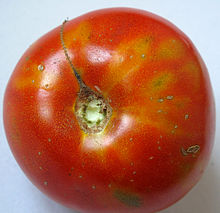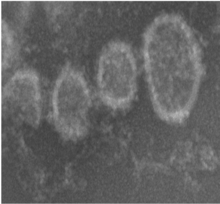Tomato spotted wilt orthotospovirus
| Tomato spotted wilt virus | |
|---|---|

| |
| Symptoms of Tomato spotted wilt tospovirus on tomato | |
| Virus classification | |
| (unranked): | Virus |
| Realm: | Riboviria |
| Kingdom: | Orthornavirae |
| Phylum: | Negarnaviricota |
| Class: | Ellioviricetes |
| Order: | Bunyavirales |
| Family: | Tospoviridae |
| Genus: | Orthotospovirus |
| Species: | Tomato spotted wilt virus
|
| Synonyms | |
| |
Tomato spotted wilt orthotospovirus (TSWV) is a spherical negative-sense RNA virus. Transmitted by thrips, it causes serious losses in economically important crops and it is one of the most economically devastating plant viruses in the world.[1]
Transmission and lifespan
[edit]
The circulative propagative transmission of TSWV is carried out by at least 10 different species of thrips.[2] The most common species is Frankliniella occidentalis (western flower thrips) as it is the vector that predominantly transmits TSWV globally and in greenhouses.[3][4] The rapid developmental and reproductive rate of the thrips contributes to the spread of TSWV. The time needed for insects to acquire the virus (acquisition period) and the time needed for the virus to move from the insect to the plant (inoculation) for TSWV varies depends on the vector species.[2] For F. occidentalis, the acquisition and inoculation of TSWV can be as short as 5 minutes. However, the acquisition and inoculation periods for optimal transmission is 21.3 hours and 42.7 hours, respectively.[5]
Transmission of TSWV can only occur when larval-stage thrips acquire TSWV. The larval stage for thrips lasts around 1–3 days.[6] TSWV is acquired by thrips when they feed on infected plants. Adult thrips cannot be infected with TSWV, as their midgut barrier successfully prevents infection.[7] However, thrips that have successfully become infected with TSWV in the larval stage can transmit the virus throughout their lifetimes.[2] To protect their eggs, thrips insert them into various types of plant tissue - eggs can be found in the stems, leaves, or flowers of plants.[8] Thrips hatch in 2–3 days and complete their lifecycle in 20–30 days.[2] Adult thrips feed on the flower bud, stem, and leaf parts of the plant.[8]
Hosts and symptoms
[edit]
TSWV infects a variety of hosts, contributing to its global economic impact on crops. Over 1000 different hosts are susceptible to TSWV.[2] The host range of TSWV includes agronomically important crops such as tomatoes and tobacco.[2] The symptoms of TSWV vary from host to host.[2] There is also variability of symptoms within a single type of host due to the age of the plant, nutrition and the environment (especially temperature).[9] Common symptoms include stunting, ringspots on fruit and necrosis of leaves.[10] Many different strains of TSWV are known, and differences in symptoms may also be attributed to the differences in the number of strains present.[3]
Genome, phylogeny, and evolution
[edit]TSWV is a spherical, negative-sense, RNA virus that has a diameter between 80 and 110 nanometers.[2] TSWV tripartite genomes are named RNAs L (8.9 kb), M (4.8 kb), and S (2.9 kb). The RNA S has two genes that encode nucleocapsid (N) and nonstructural protein (NSs).[11][12]
p202/3WT, Tarquinia, and p105 isolates were always positioned in three different lineages according to phylogenetic analysis based on full genome, RdRp, GcGn, NSm, N, and NSs genes.[13][14] TSWV isolates from worldwide shared high nucleotide and amino acid identities in N gene region.[15] Additionally, the highly conserved N gene was found to be under very strong negative selection pressures with estimated dN/dS values = 0.0638[16] and 0.0557.[15]
Management
[edit]Prevention is key in managing TSWV. Once a plant becomes infected with TSWV, no practical ways are known to cure the virus infected plant. The most efficient method of containing this disease is genetic resistance.[9] Several different resistance genes have been identified in multiple crops. In some crops, the resistance genes have been effective, but in others, some strains of TSWV have been discovered to overcome the resistance gene, such as the Sw-5 resistance gene in tomato.[17] The Sw-5 resistance gene in tomato is a dominant resistant gene.[17] The Sw-5 gene gives resistance to the TSWV through a hypersensitive response.[18] A hypersensitive response is when the plant cells that surround the infection undergo cell death, which would then deprive the virus of the cell machinery it needs to replicate and infect the plant further. Several strains of TSWV have been detected in countries such as Australia, Spain, and the United States that can overcome the Sw-5-resistant gene.[17] However, those strains of TSWV have not been spread worldwide, so the Sw-5 gene is still useful.[18]
Other important prevention techniques include buying virus- and thrips-free transplants and managing thrips populations. Introducing species that naturally prey on thrips, such as the minute pirate bugs (Orius insidiosus) and big-eyed bugs (Geocoris punctipes), may help reduce transmission of TSWV.[10] Insecticides are not an efficient way to decrease the vector population because the vectors rapidly develop resistance.[19][10] Removing weeds and infected plants is a good way to prevent more infections in the greenhouse.[3] Sanitation practices such as the destruction or removal of old crops by plowing or physical removal are often used in the field.[4]
References
[edit]- ^ Goldbach, Rob; Peters, Dick (1994-04-01). "Possible causes of the emergence of tospovirus diseases". Seminars in Virology. 5 (2): 113–120. doi:10.1006/smvy.1994.1012. ISSN 1044-5773.
- ^ a b c d e f g h JL, Sherwood; German, TL; Moyer, JW; Ullman, DE (2009). "Tomato spotted wilt virus". The American Phytopathological Society. Retrieved December 7, 2018.
- ^ a b c "Tomato Spotted Wilt Virus fact sheet". vegetablemdonline.ppath.cornell.edu. Retrieved 2018-12-08.
- ^ a b "UC IPM: UC Management Guidelines for Tomato Spotted Wilt on Peppers". UC IPM. December 2009.
- ^ Wijkamp, I.; Wetering, F. Van De; Goldbach, R.; Peters, D. (1996-10-01). "Transmission of tomato spotted wilt virus by Frankliniella occidentalism median acquisition and inoculation access period". Annals of Applied Biology. 129 (2): 303–313. doi:10.1111/j.1744-7348.1996.tb05753.x. ISSN 1744-7348.
- ^ Moritz, Gerald; Kumm, Sandra; Mound, Laurence (2004-03-01). "Tospovirus transmission depends on thrips ontogeny". Virus Research. 100 (1): 143–149. doi:10.1016/j.virusres.2003.12.022. ISSN 0168-1702. PMID 15036845.
- ^ Nagata, T; Inoue-Nagata, A K; Smid, H M; Goldbach, R; Peters, D (1999). "Tissue tropism related to vector competence of Frankliniella occidentalis for tomato spotted wilt tospovirus". Journal of General Virology. 80 (2): 507–515. doi:10.1099/0022-1317-80-2-507. PMID 10073714.
- ^ a b "Thrips - indoors". www.missouribotanicalgarden.org. Retrieved 2018-12-08.
- ^ a b Best, Rupert J. (1968). "Tomato Spotted Wilt Virus". Advances in Virus Research. 13: 65–146. doi:10.1016/S0065-3527(08)60251-1. PMID 4872838.
- ^ a b c "Tomato Spotted Wilt Virus | Public | Clemson University, South Carolina". www.clemson.edu. Retrieved 2018-12-08.
- ^ Takeda, Atsushi; Sugiyama, Kazuhiko; Nagano, Hideaki; Mori, Masashi; Kaido, Masanori; Mise, Kazuyuki; Tsuda, Shinya; Okuno, Tetsuro (4 December 2002). "Identification of a novel RNA silencing suppressor, NSs protein of Tomato spotted wilt virus". FEBS Letters. 532 (1–2): 75–79. Bibcode:2002FEBSL.532...75T. doi:10.1016/s0014-5793(02)03632-3. PMID 12459466. S2CID 28228327.
- ^ Bucher, Etienne; Sijen, Titia; de Haan, Peter; Goldbach, Rob; Prins, Marcel (15 January 2003). "Negative-Strand Tospoviruses and Tenuiviruses Carry a Gene for a Suppressor of Gene Silencing at Analogous Genomic Positions". Journal of Virology. 77 (2): 1329–1336. doi:10.1128/jvi.77.2.1329-1336.2003. PMC 140852. PMID 12502849.
- ^ Fontana, Anna; Albanese, Giuliana; Manglli, Ariana; Tomassoli, Laura; Tiberini, Antonio (2020). "Phylogenetic analysis based on full genome sequencing of Italian tomato spotted wilt virus isolates identified in "Roggianese" sweet pepper and chilli pepper". Annals of Applied Biology. 176 (2): 170–179. doi:10.1111/aab.12566. S2CID 213276964.
- ^ "Tomato spotted wilt virus (TSWV00)[Datasheet]". Global Database. EPPO (European and Mediterranean Plant Protection Organization). 2021-08-30. S2CID 242615004. Retrieved 2022-01-12.
- ^ a b Morca, Ali Ferhan; Çelik, Ali; Coşkan, Sevgi; Santosa, Adyatma Irawan; Akbaş, Birol (April 2022). "Population analysis on tomato spotted wilt virus isolates inducing various symptoms on tomato, pepper, and Chenopodium album in Turkey". Physiological and Molecular Plant Pathology. 118: 101786. Bibcode:2022PMPP..11801786M. doi:10.1016/j.pmpp.2022.101786. S2CID 245790359.
- ^ Abadkhah, Mahsa; Koolivand, Davoud; Eini, Omid (1 December 2018). "A New Distinct Clade for Iranian Tomato spotted wilt virus Isolates Based on the Polymerase, Nucleocapsid, and Non-structural Genes". The Plant Pathology Journal. 34 (6): 514–531. doi:10.5423/PPJ.OA.04.2018.0062. PMC 6305171. PMID 30588225.
- ^ a b c Cillo, Fabrizio; Montemurro, Cinzia; Bubici, Giovanni; Rienzo, Valentina di (2018-04-30). "Rapid identification of tomato Sw-5 resistance-breaking isolates of Tomato spotted wilt virus using high resolution melting and TaqMan SNP Genotyping assays as allelic discrimination techniques". PLOS ONE. 13 (4): e0196738. Bibcode:2018PLoSO..1396738D. doi:10.1371/journal.pone.0196738. ISSN 1932-6203. PMC 5927427. PMID 29709020.
- ^ a b Resende, Renato O.; Kormelink, Richard; Boiteux, Leonardo S.; Oliveira, De; S, Athos (2018). "The Sw-5 Gene Cluster: Tomato Breeding and Research Toward Orthotospovirus Disease Control". Frontiers in Plant Science. 9: 1055. doi:10.3389/fpls.2018.01055. ISSN 1664-462X. PMC 6060272. PMID 30073012.
- ^ Gao, Yulin; Lei, Zhongren; Reitz, Stuart R. (2012-08-01). "Western flower thrips resistance to insecticides: detection, mechanisms and management strategies". Pest Management Science. 68 (8): 1111–1121. doi:10.1002/ps.3305. ISSN 1526-4998. PMID 22566175.
External links
[edit] Media related to Tomato spotted wilt virus at Wikimedia Commons
Media related to Tomato spotted wilt virus at Wikimedia Commons Data related to Tomato spotted wilt orthotospovirus at Wikispecies
Data related to Tomato spotted wilt orthotospovirus at Wikispecies
